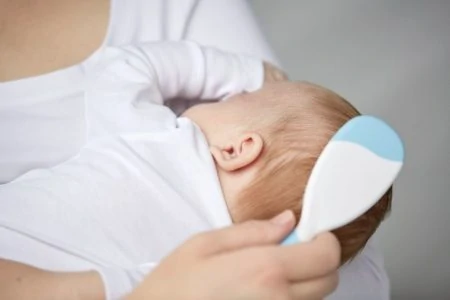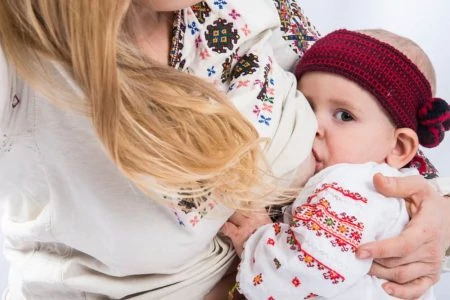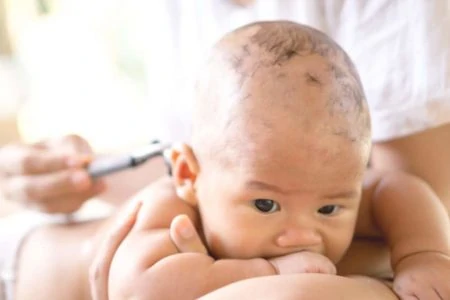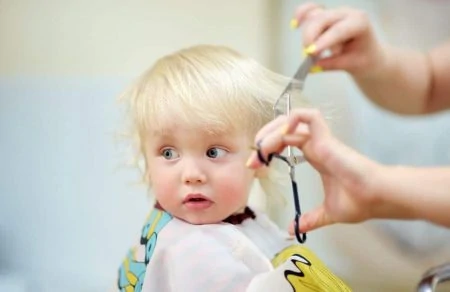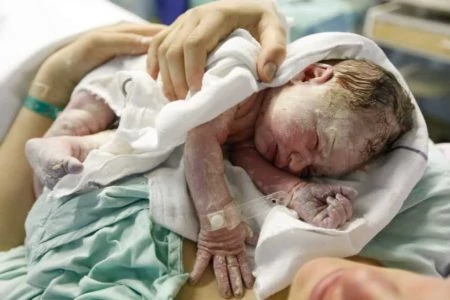Waiting for your little one to arrive is a game of patience and imagination. Will they have your partner’s chin? Your nose? And the big question: what color will their hair be?
While you can’t pick the exact shade out of a catalog, science gives us a few clues. We looked into the genetics behind hair color to help you make an educated guess before your bundle of joy arrives.
Here is the lowdown on what determines hair color, why it often changes after birth, and when you can expect that shade to stick for good.
Key Takeaways
- Genetics rule the game: Your baby’s hair color comes from a mix of alleles (gene variations) from both parents, where dark colors are usually dominant over lighter ones.
- It is all about melanin: Two pigment types, eumelanin (black/brown) and pheomelanin (red/yellow), blend together to create your child’s specific shade.
- Expect changes: It is normal for a baby’s hair color to shift dramatically during the first few years due to hormonal changes and pigment activation.
- Unique traits happen: Rare genetic conditions like albinism or poliosis (a white patch of hair) can result in distinctive hair coloring.
Can We Predict a Baby’s Hair Color?
We can certainly try, but babies love to surprise us.
While there are trillions of potential genetic combinations, the odds favor your baby looking somewhat like you or your partner. If you both have brown hair, it is highly likely your baby will too. However, if one parent has darker hair (more eumelanin), that darker pigment tends to be the “bossy” gene and often wins out (1).
It gets trickier with blonde and red shades. For years, scientists thought red hair was purely recessive and blonde was dominant over red. Now we know it is more complex. You can actually carry the “redhead gene” without having red hair yourself; it might just be hiding behind a light brown tone.
This is where family history comes in. If a grandparent had fiery red locks, that genetic trait could skip a generation and show up in your newborn. The pigment instructions are simply waiting for the right combination to activate.
What Determines Baby’s Hair Color?
Your baby’s hair color is decided the instant fertilization happens. The sperm and egg fuse to form a single cell (zygote) containing a complete genetic blueprint. That is 23 chromosomes from mom and 23 from dad (2).
Think of this tiny cell as a zipped file containing everything that makes your baby unique. It holds instructions for eye color, personality quirks, and, of course, hair color.
Because each sperm and egg carries a slightly different mix of the parents’ DNA, every pregnancy is a unique roll of the dice. Your first child might be your clone, while your second looks exactly like your partner.
Let’s break down how the biological machinery works.
1. The Power of Genes
Genes are the heavy lifters here. Humans carry around 100,000 genes, creating nearly infinite possibilities for what your child could look like (3).
Your baby’s DNA is packaged in “alleles,” which are usually described as dominant or recessive.
- Dominant alleles: These typically produce darker hair colors.
- Recessive alleles: These typically produce lighter hair colors.
This is why a mom with blonde hair might be shocked when her baby arrives with a full head of black hair like dad (4).
However, hair color is a “polygenic” trait. That means it isn’t decided by just one switch. Multiple genes work together, blending their instructions. This blending is what gives us the beautiful spectrum of human hair color, from platinum blonde and strawberry blonde to jet black and deep chestnut.
2. Pigmentation
Genes provide the blueprint, but melanin is the paint. Melanin is the pigment responsible for the color of our skin, eyes, and hair. It comes in two primary varieties:
- Eumelanin: Creates brown and black shades.
- Pheomelanin: Creates red and yellow shades.
The specific shade your baby ends up with depends on how much of each type they have and how it is distributed in the hair shaft.
One of the key players here is the MC1R gene (5). This gene gives instructions to a protein called the melanocortin 1 receptor. Think of this receptor as a dimmer switch:
- High activation: The cells pump out eumelanin, resulting in dark hair.
- Low activation: The cells produce pheomelanin, leading to strawberry blonde, auburn, or red hair.
- Blocked receptor: This usually forces pure pheomelanin production, creating bright red hair.
Could My Baby’s Hair Color Change?
Absolutely. In fact, you should almost expect it. The color you see in the delivery room is rarely the final color.
Babies are often born with finer hair (sometimes lanugo) that falls out and is replaced. Furthermore, melanin production ramps up as the child grows. This darkening process can continue well into elementary school, stopping around age six or seven.
However, puberty can trigger another shift. Hormones influence the expression of genes, including those that regulate pigmentation. It is very common for children with towhead blonde hair to see it darken to a “dishwater” blonde or light brown by their teenage years (6).
Unique Hair Color Conditions
Sometimes, genetics throw a curveball. Certain conditions, often caused by a “loss of function” in specific genes, can create striking and unusual hair patterns.
1. Poliosis
Poliosis, often called a “white forelock,” is a condition where a patch of hair is completely white while the rest is colored (7).
This happens because the hair follicles in that specific spot have no melanin. It is a distinct look that can be hereditary. While it can be associated with genetic syndromes like Waardenburg syndrome or tuberous sclerosis, it can also occur on its own or be triggered by minor skin issues.
If your baby has a white patch, your pediatrician will likely check them over just to be safe. However, most people with poliosis are perfectly healthy and rock a very cool, unique hairstyle naturally.
2. Albinism
Albinism is a genetic condition where the body produces little to no melanin. This affects the hair, skin, and eyes.
In the U.S., albinism affects roughly one in 18,000 to 20,000 people (8). It is a recessive trait, meaning both parents usually must carry the gene for the baby to be born with it.
Because babies with albinism lack protective pigment, they are extremely sensitive to UV rays. Sun safety is non-negotiable. Applying baby-safe sunscreen, using wide-brimmed hats, and keeping skin covered is essential to prevent burns and long-term damage.
Albinism can also affect vision, so early eye exams are important for these little ones.
Baby Hair Color FAQs
In Conclusion
Guessing your baby’s hair color is a fun way to bond with your partner and dream about the future. Whether they come out with a peach-fuzz dome, jet-black spikes, or shocking red curls, they will be perfect to you.Just remember that the hair color you see on day one might not be the one they head to kindergarten with. Genes are mysterious, and pigment takes time to settle. Enjoy the surprises along the way!

